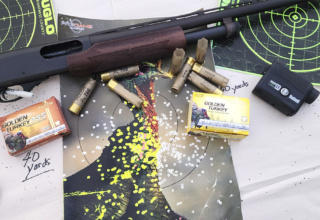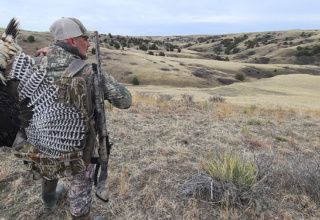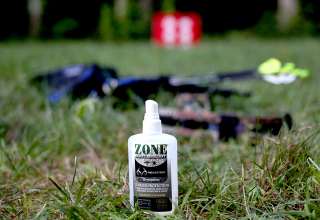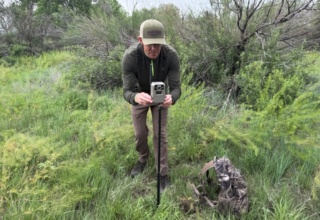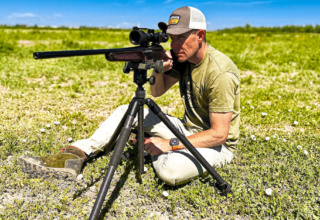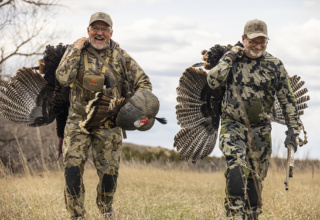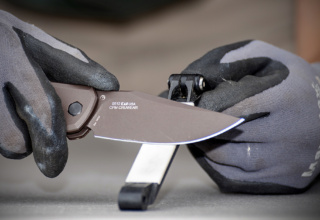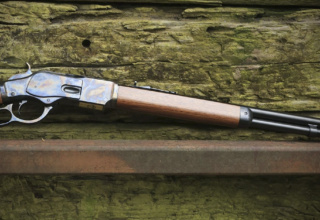These three simple calls are all you need to bring in your spring gobbler
by Pete Rogers
Turkey hunting has been described as a disease by some and an addiction by others. Many of these descriptions are true, but perhaps the best description comes from turkey hunting legend Colonel Tom Kelley, who said in his book Tenth Legion, “I do not hunt turkeys because I want to, I hunt them because I have to. I would, really, rather not. I am helpless in the grip of my compulsion.”
For the few who enter the spring woods wide-eyed and hopeful that a strutting tom will majestically appear on the edge of the field in search of a mate that you are imitating, spring turkey hunting is life-changing. There is nothing, at least in my mind, as close to heaven this side of glory than the thundering gobble of a mature tom just after sunrise.
As a junior in high school, I was fortunate enough to live in the bastion of the eastern wild turkey. The National Wild Turkey Federation was only a few miles down the road and the organization’s restocking programs were well underway. Turkeys were abundant, and so was my desire to kill one.
I read everything I could get my hands on about the wary old bird — how to set up, how to scout for scratching in the leaves, and how to call him. For those of you who are itching to get into the woods but are not sure where to begin, here are some tips on what calls to use and how to use them that will flatten your learning curve and, hopefully, put a mature tom in your sights this spring.
When calling a wild turkey, there are only three calls you need to master: the yelp, the cluck, and the purr. There are other calls that some turkey chasers like to claim are necessary, but they really aren’t, such as cackles, fly-down calls, the kee-kee run, and a few others. These are what I would term gravy for this meal. And as most Southerner’s know, gravy is fine when presented right and horrible when it is not. For now, we will forget the gravy.
I have taught calling turkeys for some time now, so let’s break it down to the basics and keep it simple. Forget the diaphragm call for the beginner. It is, at least in my experience and estimation, one of the more difficult to master. Instead, let’s start with the friction calls. Examples are a good double-sided box call and a real slate call, such as the Turkey Strutter box call and the Strike a Strut slate call from Rocky Mountain Hunting Calls.
From personal experience, the slate call, also called a pot call, is the simplest to use and master. In the 40 years I have hunted this bird, more have met their demise to my slate call than any other call I have used.
Learning how to yelp on a Strike a Strut slate call is simple. As a right-handed person, I hold the call in my left hand and the striker in my right hand. I apply slight pressure on the call with the striker and draw circles on the call. As the striker moves around the call, it will produce a yelp, yelp, yelp sound. The amount of pressure you place on the call and the size of the circles all affect the sound. Consistent pressure is important here.
A large circle will be a more drawn out yelp, while smaller circles will produce shorter higher-pitched yelps. Both long and short yelps are effective in calling the male turkey. The more pressure you apply, the more volume you achieve.
Once you have practiced and are comfortable making the yelp, it’s time to learn the cluck, which is a very short, sharp sound. I make this with the Strike a Strut slate by holding the call firmly in my left hand, placing the striker in the center of the call with the top angled away from me and applying pressure to the call. As I apply more pressure and slightly tilt the top of the striker away from me, the call slips on the slate and makes a perfect cluck. The sharper and crisper the sound, the better.
To put these two calls together, begin with the yelp, yelp, yelp, followed by two soft clucks. Basically, this is all you need to kill turkeys. Once you have these calls down, work on cadence. I have learned through experience that cadence is perhaps the key to calling turkeys. More than perfect yelp or cluck is the cadence in which they are presented. All experienced turkey killers know that every turkey might sound different, just as people do. But the cadence from one bird to the other is identical.
A purr is a great addition to these calls and is made simply by applying light pressure and dragging the striker across the slate: puuuuurrrr, puuuuurrrr, puuuuurrrr. This may be the most overlooked call in the turkey hunter’s arsenal. If you have ever watched turkeys that are feeding unalarmed, you will hear the soft, faint puuuuurrrr, puuuuurrrr they make to one another. This is a calming call and lets them know where one another are in the group. A purr is soft, and when you think you are making it soft enough, quiet it down and make it a little softer. Remember, the male turkey has excellent hearing, and just as no man likes to be yelled at, neither does a tom turkey. Soft, subtle calls work far better than screaming ones.
When in doubt of the location of a turkey I am working, I default to the purr on my slate to get his attention. A soft purr every five to ten minutes lets him know where I am and that I am still interested.
Box calls are also easy to learn to use, and the Turkey Strutter Box is no exception. Some people hold the paddle or lid backwards. Personally, I use it frontwards and have gotten accustomed to using it the way it was designed. Others find it easier to use backwards, but go with whatever works for you. I cannot make clucks or purrs when using it backwards.
With the Strutter box call, the yelp is made by simply dragging the paddle across the box. The longer the stroke, the longer the yelp. The more pressure you place on the paddle, the louder it is.
While holding the box in your left hand (as a right-handed person), take the paddle and open the box. Move the paddle to the right, opening the sound chamber. Placing the paddle on the box, close the opening with steady movement and pressure. You should get a yyyyeeeellllppp. Again, the longer the movement, the longer the yelp. More pressure is louder, less pressure is softer.
There is one caveat. For a box call to work well, the paddle needs chalk applied to it frequently. If there is no chalk on the paddle, it does not glide across the box. It jumps and resembles a trumpeter swan dying a horrible death more than it does a turkey in love. In short, keep your paddle chalked.
When it comes to friction calls, moisture is your nemesis. Rain, dew, sweat, spit — you name it and the call quickly becomes ineffective. If I am in a slight rain or drizzle, I combat this by using a disposable lighter to dry off my slate call. The box is not good at all in the rain. For the beginner, leave it in your vest.
Lastly, one of the benefits of a Strike a Strut slate call is the versatility it offers. It is shocking how changing strikers can completely alter the sound the call makes. I will routinely carry five or six different strikers — mahogany, walnut, holly, Dymondwood, carbon, or others — with me for one slate call.
Do not hesitate to experiment and learn. Learn the yelp, cluck, and purr and learn them well. Practice your cadence and you will be on your way to an obsession that may change your life.









